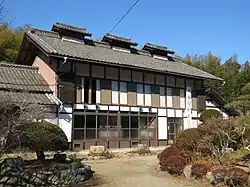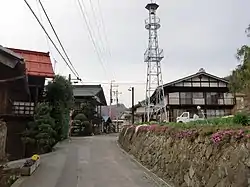The Tomioka Silk Mill and Related Industrial Heritage (富岡製糸場と絹産業遺産群, Tomioka seishijō to kinu sangyōisangun) is a grouping of sites that relate to the industrialization of Japan in the Meiji period, part of the industrial heritage of Japan. The Tomioka silk mill was constructed in 1872 in Gunma Prefecture, which became a leading centre for sericulture, the rearing of silkworms and production of raw silk. In 2007 the monuments were submitted jointly for inscription on the UNESCO World Heritage List under criteria ii, iv, and v. Ten component sites have been proposed (listed below).[1] Four sites were retained in Tomioka Silk Mill and Related Sites in 2014:[2]
- Tomioka Silk Mill
- Tajima Yahei Sericulture Farm
- Takayama-sha Sericulture School
- Arafune Cold Storage
| Site | Comments | Image | Location |
|---|---|---|---|
| Tomioka Silk Mill (富岡製糸場, Tomioka seishijō)[3][4][5] | established in 1872 by the Meiji government; closed in 1987; Wada Ei described conditions in the mill; Important Cultural Property with eight designated structures; Historic Site |  | Tomioka 36°15′21″N 138°53′13″E / 36.25583°N 138.88694°E |
| Great Mulberry of Usune (薄根の大クワ, Usune no ōkuwa)[6][7] | the largest wild mulberry in Japan; Natural Monument |  | Numata 36°40′48.94″N 139°2′42.41″E / 36.6802611°N 139.0451139°E |
| Arafune Fuketsu (荒船風穴, Arafune fuketasu)[8] | cold storage facility for preserving silkworm eggs during the summer |  | Shimonita 36°14′48.79″N 138°38′7.76″E / 36.2468861°N 138.6354889°E |
| Azumaya Fuketsu (東谷風穴, Azumaya fuketasu)[9] | cold storage facility | Nakanojō 36°38′14.3″N 138°52′29.4″E / 36.637306°N 138.874833°E | |
| Birthplace of Takayama-sha (高山社跡, Takayamasha ato)[10] | where a method of silkworm rearing was developed |  | Fujioka 36°12′12.7″N 139°1′55.2″E / 36.203528°N 139.032000°E |
| Tomizawa house (富沢家住宅, Tomizawake jūtaku)[11][12] | 1792; silk farmer's house; Important Cultural Property |  | Nakanojō 36°39′45.3″N 138°51′19.7″E / 36.662583°N 138.855472°E |
| Group of silk-raising farmhouse in the Akaiwa District (中之条町六合赤岩, Nakanojō machi kuni akaiwa)[13][14] | Group of Traditional Buildings |  | Nakanojō 36°34′37″N 138°37′37″E / 36.57694°N 138.62694°E |
| Old Kanrasha Obata-gumi warehouse (旧甘楽社小幡組倉庫, kyū Kanrasha Obatagumi sōko)[15] | for storing raw silk |  | Kanra 36°13′54.80″N 138°55′5.78″E / 36.2318889°N 138.9182722°E |
| Old Usui Pass railroad infrastructure (碓氷峠鉄道施設, Usui tōge tetsudō shisetsu)[16][17][18] | designed by British architect C.A.W. Pownall; Important Cultural Property with seventeen designated structures |  | Annaka 36°21′29.43″N 138°41′52.78″E / 36.3581750°N 138.6979944°E |
| Old Kōzuke Railway and facility (旧上野鉄道関連施設, kyū Kōzuke tetsudō kanren shisetsu)[19] | light railway for the local silk industry |  | Shimonita 36°13′34.15″N 138°47′36.37″E / 36.2261528°N 138.7934361°E |
See also
Wikimedia Commons has media related to Tomioka Silk Mill.
Wikimedia Commons has media related to Usui Bridge No. 3.
References
- ↑ "The Tomioka Silk Mill and Related Industrial Heritage". Gunma Prefecture. Retrieved 19 February 2012.
- ↑ Tomioka Silk Mill and Related Sites (maps) at UNESCO website
- ↑ "The Tomioka Silk Mill". Gunma Prefecture. Archived from the original on 4 December 2013. Retrieved 19 February 2012.
- ↑ "旧富岡製糸場". Agency for Cultural Affairs. Archived from the original on 22 February 2012. Retrieved 19 February 2012.
- ↑ Finn, Dallas (1995). Meiji Revisited: The Sites of Victorian Japan. Weatherhill. pp. 22–4. ISBN 0-8348-0288-0.
- ↑ "The Great Mulberry of Usune". Gunma Prefecture. Archived from the original on 1 August 2012. Retrieved 19 February 2012.
- ↑ "薄根の大クワ". Agency for Cultural Affairs. Retrieved 19 February 2012.
- ↑ "Arafune Fuketsu". Gunma Prefecture. Archived from the original on 4 December 2013. Retrieved 19 February 2012.
- ↑ "Azumaya Fuketsu". Gunma Prefecture. Archived from the original on 18 July 2012. Retrieved 19 February 2012.
- ↑ "The Birthplace of Takayama-sha". Gunma Prefecture. Archived from the original on 4 December 2013. Retrieved 19 February 2012.
- ↑ "The Tomizawa house". Gunma Prefecture. Retrieved 19 February 2012.
- ↑ "富沢家住宅 (群馬県吾妻郡中之条町)". Agency for Cultural Affairs. Archived from the original on 29 July 2012. Retrieved 19 February 2012.
- ↑ "Group of silk-raising farmhouse in the Akaiwa District". Gunma Prefecture. Archived from the original on 16 July 2012. Retrieved 19 February 2012.
- ↑ "中之条町六合赤岩". Agency for Cultural Affairs. Retrieved 19 February 2012.
- ↑ "Old Kanrasha Obata-gumi warehouse". Gunma Prefecture. Archived from the original on 17 July 2012. Retrieved 19 February 2012.
- ↑ "Old Usui Pass Railroad Infrastructure". Gunma Prefecture. Archived from the original on 21 July 2012. Retrieved 19 February 2012.
- ↑ "碓氷峠鉄道施設". Agency for Cultural Affairs. Archived from the original on 20 August 2011. Retrieved 19 February 2012.
- ↑ Finn, Dallas (1995). Meiji Revisited: The Sites of Victorian Japan. Weatherhill. p. 148. ISBN 0-8348-0288-0.
- ↑ "Old Kōzuke Railway and Facility". Gunma Prefecture. Archived from the original on 23 July 2012. Retrieved 19 February 2012.
External links
This article is issued from Wikipedia. The text is licensed under Creative Commons - Attribution - Sharealike. Additional terms may apply for the media files.